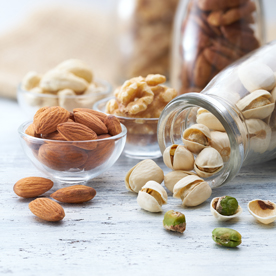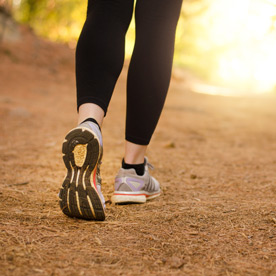
Whether you have been newly diagnosed with PCOS or have lived with the condition for several years, you most probably are aware of the other conditions it is linked with. You may have gathered this information online or may have received it from your healthcare professional, and it most likely seems very overwhelming. The facts and figures may seem intimidating, but understanding the additional risks your body might be under can be a way to actively combat them.
One such condition often found to coincide with PCOS is high cholesterol. However, the good news is if you do develop high cholesterol – or indeed any of the other long-term health effects of PCOS – it can be managed effectively with your own self care and help of your experts.
Coming to terms with cholesterol
Raised cholesterol is very common in the general population however, it’s been shown that this risk increases if you have PCOS. One study suggested 70% of women with PCOS are affected by dyslipidemia, which is when you have unhealthy levels of one or more kinds of lipid – cholesterol and another type of fat called triglycerides – in your bloodi.
Cholesterol is a fat-like substance made by your body, mostly by your liver. You need some cholesterol to make vitamin D and certain hormones but when too much cholesterol and other substances build up in the walls of your arteries, it causes atherosclerosis. Atherosclerosis – or hardening of the arteries – makes it harder for blood to flow through and increases your risk of cardiovascular disease.
 Cholesterol is also often called the ‘silent’ killer, because if your cholesterol is high, it doesn’t usually cause any symptoms. Indeed, some people only find out they have high cholesterol when they are affected by a serious health problem such as a heart attack, stroke or angina. Other conditions caused by high cholesterol include chronic kidney disease and peripheral vascular disease, which causes pain in the arms and legs.
Cholesterol is also often called the ‘silent’ killer, because if your cholesterol is high, it doesn’t usually cause any symptoms. Indeed, some people only find out they have high cholesterol when they are affected by a serious health problem such as a heart attack, stroke or angina. Other conditions caused by high cholesterol include chronic kidney disease and peripheral vascular disease, which causes pain in the arms and legs.
The insulin connection
So why does having PCOS mean you may also develop high cholesterol? Many experts believe the problem may stem from insulin resistance, which is thought to affect up to 70% of women with PCOSii.
If you have insulin resistance, your body’s tissues are resistant to the effects of insulin, a hormone produced by your pancreas to help control your blood sugar levels. And because your tissues are resistant, your pancreas produces higher and higher levels of insulin to compensate. Insulin resistance can lead to the development of type 2 diabetes because your pancreas eventually fails to produce enough insulin to control your blood sugar levels or your body’s cells stop reacting to insulin completely. If you are struggling with type 2 diabetes, understanding its link with PCOS can be key to managing your condition.
Many scientists have noted that both insulin resistance and type 2 diabetes are frequently associated with dyslipidaemiaiii, specifically high triglyceride levels and low levels of ‘good’ cholesterol (high-density lipoprotein or HDL)iv. HDL is the type of cholesterol you need more of because it helps remove ‘bad’ cholesterol (low-density lipoprotein or LDL) from your blood. So ideally you need low levels of LDL and higher levels of HDL.
Researchers have also discovered that LDL cholesterol particles in people with insulin resistance are smaller and more dense than those who don’t have insulin resistance, which is also thought to be strongly linked to an increased risk of coronary heart diseasev.
How is cholesterol treated?
If you have PCOS, your healthcare team should be routinely screening you for cardiovascular risk factors, including high cholesterol. Testing your cholesterol involves having a fasted blood test, where you shouldn’t usually eat or drink anything besides water for 10-12 hours beforehand. Your GP or a nurse will take a sample of your blood and send it to the lab, where your LDL, HDL and triglycerides levels will be measured. If your total cholesterol – your LDL and HDL combined – turns out to be higher than it should be, you may be offered prescription medicines such as statins.
There are also lots of things you can do for yourself to help get your cholesterol into the healthy range (5mmol/L or lower), including the following:
Eat a low-fat diet
Experts generally recommend a diet low in saturated fat as a way of reducing or preventing raised cholesterol levels. So switch fatty meat, full-fat dairy foods and butter for vegetable oils, lean meats, fish, nuts and lower-fat dairy. Also try grilling, steaming or baking your foot instead of frying. Olive oil – which is a monounsaturated fat – is also believed to help reduce LDL while maintaining HDL.
Keep moving
Being physically active on an ongoing basis may help maintain a healthy cholesterol level as exercise is widely thought to help increase HDLvi. Aim to do at least 150 minutes of moderate-intensity exercise every week – you should feel slightly out of breath and feel your heart rate raised. Take a look at our top tips for getting started!
Try plant stanols/sterols
These substances, such as beta-sitosterol, are found in plants and are added to foods such as yoghurts and margarine spreads. There is a wide body of evidence to suggest eating plant stanols and sterols may help lower cholesterol in some people with mildly or moderately raised levels.
Eat more soya
According to Heart UK, soya foods are naturally low in saturated fat and soya protein has been shown to actively lower cholesterol. The charity’s Ultimate Cholesterol Lowering Plan includes soya foods such as tofu, soya burgers, soya milk, soya beans (edamame), soya yoghurt and soya mince or chunks.
Have oats for breakfast
Any foods that contain soluble fibre may be helpful if you’re trying to lower or maintain your cholesterol as experts believe soluble fibre transports bile acids – which are made from cholesterol – out of your body. But oats may be particularly useful as they contain a type of soluble fibre called beta-glucan, which has been proven to help maintain healthy cholesterol levels. As well as porridge for breakfast, try having oatcakes whenever you need a snack, or sprinkle oatbran over soups, stews, cereals and yoghurts. You can also get more soluble fibre in your diet by eating lots of fruit, vegetables, beans and lentils.
Give it up
If you’re a smoker there are many health-related reasons why you should quit – and raised cholesterol is one of them. According to Heart UK, smoking reduces your levels of HDL and makes cholesterol more likely to stick to the inside of your artery walls. Ask your GP for help with giving up smoking or visit the Smokefree website.
High cholesterol needn’t be something which affects you or makes living with PCOS any more difficult. Just be aware of where your body is when it comes to cholesterol and make sure you put the right measures in place to keep your levels healthy. For more advice on managing your PCOS symptoms and any related conditions explore our hub.
References:
-
Legro, R.S., Kunselman, A.R., Dunaif, A. (2001 Dec). Prevalence and predictors of dyslipidemia in women with polycystic ovary syndrome. Am J Med. 1;111(8):607-13. Available online: https://www.ncbi.nlm.nih.gov/pubmed/11755503/
-
Marshall, J.C., Dunaif, A. (2012 Jan). All Women With PCOS Should Be Treated For Insulin Resistance. Fertil Steril. 97(1); 18-22. Available online: https://www.ncbi.nlm.nih.gov/pmc/articles/PMC3277302/
-
Pihlajamaki, J., et al. (2004). Insulin resistance is associated with increased cholesterol synthesis and decreased cholesterol absorption in normoglycemic men. J of Lip Res. Vol 45, 2004; 507-512. Available online: http://www.jlr.org/content/45/3/507.full.pdf
-
Wild, R.A., Rizzo, M., Clifton, S., Carmina, E. (2011 Mar). Lipid levels in polycystic ovary syndrome: systematic review and meta-analysis. Fertil Steril. 1;95(3):1073-9.e1-11. Available online: https://www.ncbi.nlm.nih.gov/pubmed/21247558/
-
Reaven, G.M. (1995 Jul). Pathophysiology of insulin resistance in human disease. Physiol Rev. 75(3):473-86. Available online: https://www.ncbi.nlm.nih.gov/pubmed/7624391
Toth, P.P. (2014). Insulin resistance, small LDL particles, and risk for atherosclerotic disease. Curr Vasc Pharmacol. 12(4):653-7. Available online: https://www.ncbi.nlm.nih.gov/pubmed/23627975 -
Mann, S., Beedie, C., Jimenez, A. (2014). Differential Effects of Aerobic Exercise, Resistance Training and Combined Exercise Modalities on Cholesterol and the Lipid Profile: Review, Synthesis and Recommendations. Sports Med. 44(2): 211–221. Available online: https://www.ncbi.nlm.nih.gov/pmc/articles/PMC3906547/
Related Posts?
Disclaimer: The information presented by Nature's Best is for informational purposes only. It is based on scientific studies (human, animal, or in vitro), clinical experience, or traditional usage as cited in each article. The results reported may not necessarily occur in all individuals. Self-treatment is not recommended for life-threatening conditions that require medical treatment under a doctor's care. For many of the conditions discussed, treatment with prescription or over the counter medication is also available. Consult your doctor, practitioner, and/or pharmacist for any health problem and before using any supplements or before making any changes in prescribed medications.

Olivia
Olivia Salter has always been an avid health nut. After graduating from the University of Bristol, she began working for a nutritional consultancy where she discovered her passion for all things wellness-related. There, she executed much of the company’s content marketing strategy and found her niche in health writing, publishing articles in Women’s Health, Mind Body Green, Thrive and Psychologies.
View More



